You’ve probably encountered it in your Netflix recommendations—images for some strange show that seems to be (and is) exclusively about very small Japanese children—and when you did, you surely responded in one of the only two possible ways: either you immediately binged all of it in one sitting and experienced hours of the purest joy, sorrow, and mystery available to humankind; or you absently scrolled past it in mild confusion, never quite curious enough to see what it actually is.
Well I am here—as I am every Friday—to tell you the truth:
Old Enough! is the goddamn apex of drama.
Unless you are a soulless, amoral monster—or just one of those tragic people who project their own childhood traumas onto the world by building a whole personality around the proud declaration “I hate kids”—I promise that you will never find a piece of media that will make you laugh, cry, and smile this hard, this often, in this short a span of time, in nearly every episode.
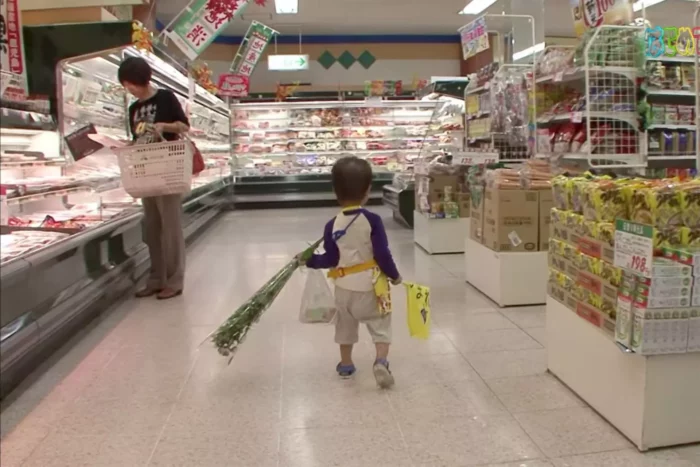
First, the backstory: Hajimete no Otsukai, or literally My First Errand, is a show that has been airing in Japan, on and off, since 1991. Apparently it had humble origins as a mere segment of an “information program” called Tsuiseki (The Chase) that debuted in 1989—and ever since that show ended, the segment to end all segments has lived on as an irregularly scheduled series of one-shot specials that run from two to three hours apiece. As you may have pieced together by now, the show zooms in on families who are embarking on what it portrays as a proud but emotionally sensitive Japanese tradition: the first time a young child is sent out of the home to complete an errand all by themselves.
The version available to Netflix users in English-speaking countries, called Old Enough!, is then a sort of anthology of anthologies: it culls segments from the original series, freely plucking from the entire span of its history, and trims down each family’s journey into a discrete, 10 to 15 minute freestanding episode. So far Netflix has brought us two such doubly curated “seasons” of this pure unscripted bliss, first a diverse sampler platter of 20 episodes and then another selection of 10 more.
It’s far from uncommon for any one of these bite-sized portions to encapsulate—in the span of a fucking Adult Swim cartoon—all the heart-wrenching trials, tribulations, and emotional highs and lows of a great Romantic epic or Hero’s Journey fantasy melodrama. Thanks perhaps to the two layers of curation and editing that have gone into translating these deeply Japanese narratives into a hyper-digestible, universally accessible package for English-speaking markets—admittedly a cynical capitalist project that only via profitability flirts with any lofty ideals of multiculturalism—the result is quite literally the most densely packed emotional rollercoaster I have ever encountered.

Now that we’re on the same page and you have a working image of what Old Enough! actually is, you’re probably, again, responding in one of the only two possible ways (at least for the vast majority of readers likely to peruse this site): either you’re thinking, Well that sounds boring—or, if you’re an interesting person, you’re thinking, How cute! How magical! How…wait, did you say toddlers?
You bet your Western ass I did. Across a range of years that already spans from 1990 to at least the initial COVID lockdown age, and across a range of landscapes and lifestyles from the densely populated and semi-urban to the rural and authentically pastoral, this is a show where children ranging from ages three to six—and sometimes younger—literally go walk around the city, take the fucking bus, climb over all kinds of environmental obstacles unique to Japanese architecture, and interact with up to dozens of unknown adults, entirely by themselves.
Of course, there is a camera crew hovering around. Though the camera operators are disguised as “electricians” and instructed not to actively engage with the child or interfere directly with the child’s journey, we can safely assume that if one of the kids was in any real trouble, the production would step in.
But this really is an actual tradition in Japan—albeit one that may be slowly fading away—and the original show’s makers seem to insist that their aspiration is to get as close to vérité as they can:
[Executive director Junji] Ouchi said the original idea behind the show had been to “document the ‘errand tradition’ before it gradually disappears.”
“Family situations have changed drastically over the 30-plus years since we started this, yet in Japan, the tradition of sending children on errands remains,” he said. “We didn’t feel like we were making a show for television. It was more of a documentary. (We tried) to find families who would allow us to record their stories.”
So at this point, you’re likely left with the same questions we all quickly ask:
Isn’t this too dangerous?
How is no one kidnapping all these kids?
How can they possibly figure out how to navigate public spaces on their own?
But this process—that literally every single American who hears about this show goes through within the first 15 minutes of knowing what it is—reflects one of the great, pervasive problems of cultural exchange: the questions asked say more about the asker than they do about the object of inquiry.

Before we dive all the way into how the United States is a dying empire soon to crumble under the weight of its own ideology, let’s take some time to appreciate a reality TV show on its own merits.
The raw, unmitigated joy of Old Enough! is, self-evidently, the children. There is incredible hope, light, dramatic tension, and hold-your-breath-in-terror suspense to be found in watching these tiny little people—whom most of us are frankly not used to regarding as people—navigate a gauntlet of challenges that are simple and everyday to us, but unprecedented and seemingly insurmountable to them.
From this core premise emerges another, less obvious layer of humanist beauty: the children we follow all express wildly different, personal, and unique responses to both the request put before them and the specific hiccups and obstacles that arise along the way.
Of the kids brought to Netflix so far, naturally a few immediately resist the assignment: crying plaintively, openly resisting, reacting nonchalantly like it’s not a serious proposition. Others are just surprised or confused and take a little convincing, carrot-on-stick baiting, or even strategic ignoring to get their engines started. Still others are thrilled at the adventure or responsibility of it all, sometimes having anticipated this moment for some time—occasionally even trying to march right out, straight away, without any of the necessary information or supplies.
Personally, my favorite episodes tend to come in a few flavors. There are several hilarious episodes about precociously confident kids who might shout “Konnichiwa!” at everyone they pass, or loudly sing songs to themselves about what a great job they’re going to do. Then there are the shy, anxious, or insecure kids who don’t fully believe in themselves. Kids on the show often have to double back or retry things because they’ve forgotten parts of their task, or run into an unexpected problem. Inevitably, they somehow persevere and fulfill their mission to the best of their ability. Occasionally these narrative flavors mix, such as when one girl must come up with a creative solution to pulling up a vegetable from the ground despite her limited strength—and ends up spending most of her afternoon vigilantly twisting it.
This diversity in how the show’s subjects handle the experience has a remarkable humanizing effect that’s exceptionally rare for depictions of children this young. It offers a unique lens on the ways in which children under a certain vague age are often portrayed in media as essentially some flavor or automatons, feral animals, straight-up nuisances, or mechanical plot obstacles. Rarely are children this young depicted this authentically or with this kind of autonomy and agency.
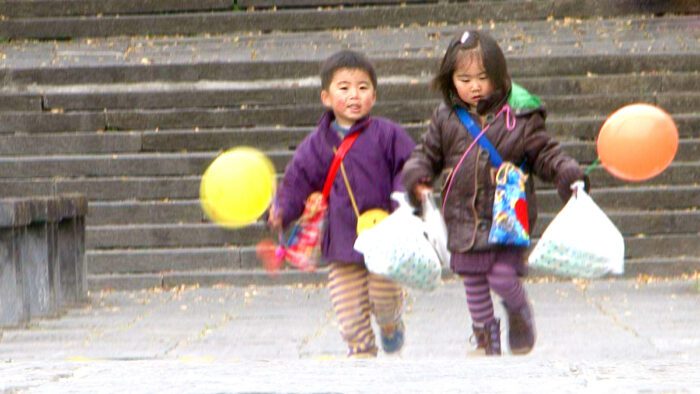
Another subtle level to the show is that we get to observe children who, as far as they know, have no familiar adults around to answer to or put on a performance for. In this way, we get to witness a kind of sincere expression and personality in them that is essentially impossible with the children in our actual lives, for whom we inevitably have some behavior-altering emotional significance or authority status. Unaware of their observers, our tiny heroes get to remain in a magical kind of quantum childhood superposition, uncollapsed by our pesky prying eyes, un-self-consciously acting as both a particle and a wave.
This is especially highlighted in one of the best subgenres within the show: episodes in which two kids are sent out on their errand together. Sometimes they’re siblings; sometimes they’re the best of friends; sometimes they exhibit amusing and/or troubling gender dynamics; and in one or two memorable episodes they appear to be in some fledgling state of kid-love. In episodes like these, both the operatic melodrama and voyeuristic intimacy of the show are at a peak, offering a touching glimpse of one of the most important and elusive dimensions of human experience: how children actually interact with each other when there are no meddling authority figures around.
In Season 2, this includes a standout episode where a boy-girl pair of siblings, arguing over who gets to carry what, share a shattering formative trauma: one of them shouts “I hate you!” at the other for what seems like the first time in their little lives. Both react to this moment with gutwrenching agony, and after a fraught moment that feels like forever, they each tearfully, effusively apologize to the other. These kinds of social negotiations with each other and with strangers—realms that are difficult to navigate even for most adults—are emblematic of the inspiring intelligence and startling sense of purpose that Old Enough! finds in small children.
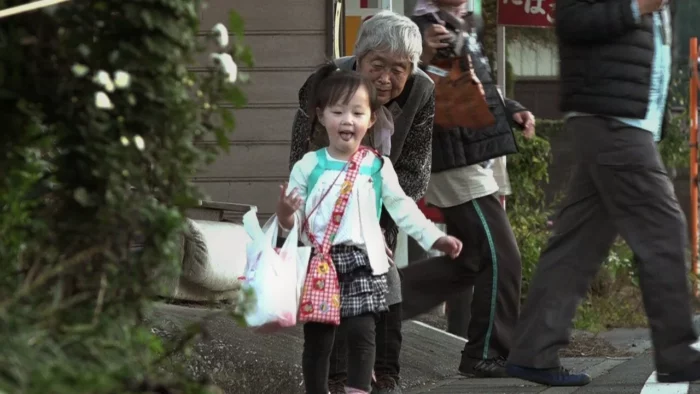
Yet another subgenre of standout episodes center on the ways adults relate to the children and their task. The anxiety of parents waiting for their children’s safe return is often palpable and comes in a variety of flavors. The experience can be a challenging point of growth even for them, especially the more doting, “spoiling” parent of a pair; and more often than you might guess, a parent who was initially gung-ho about pushing the kid out the door to go do some maturing ends up themselves nervous and agitated the whole time. Contrary to common Western stereotypes, the former is almost always a father and the latter is almost always a mother.
Arguably even more compelling, several of the show’s most powerful stories involve the way a local community rallies to support a child on the go. There are plenty of heartwarming little interactions with friendly shopkeepers, attentive bus drivers, and so on, who are more than happy to go a little bit out of their way to help the tykes cross off their tasks—often offering supportive remarks of “Do your best!” or “What a good girl/boy you are!” or “Your mother will be very proud!” In S1E7, perhaps the most beautiful, tears-of-joy-bait episode of Season 1, all the ladies that work in the shops of a close-knit community’s small commercial district come out onto the street to chant cries of support for the absolute cutest little girl that has ever existed.
In a similarly stirring sequence in S2E8, a little girl who loves to quote the can-do attitude of a beloved picture book has to bring her mother’s ripped pair of pants to a local shop to get them sewn up. It turns out that the store doesn’t actually offer sewing services; they just happen to have a dusty old sewing machine around. The elderly woman who manages the store talks of how great she used to be at sewing, but now she’s less confident in her skills and isn’t even sure the machine will work. Nevertheless, she fires the old thing back up and goes through a touching little arc of her own—all while thinking this is just a nice favor she’s doing for a local child, because the girl forgot to start off by saying she’d also be buying some flour.
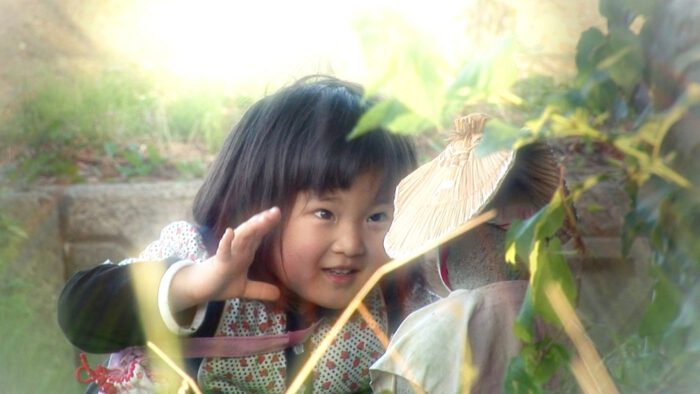
This exemplifies how, in a subtle, peculiar way, the specter of mortality looms over Old Enough! We see it in the extra enthusiasm that older folks show for interacting with the little ones, especially once they find out the children are at this pivotal early milestone in Japanese life. We see it in the intimate glimpses of kids on a mission still dutifully stopping to honor their ancestors at small roadside familial shrines or Jizō statues.
We see it especially in the heady mix of relief, excitement, and mono no aware that often wells up in parents’ eyes as they see their plucky, imperceptibly older kiddo stomping home at last—knowing as a parent must that in exchange for this special, empowering moment their child has had to quietly cross an invisible line that can never be crossed back over, marking the end of childhood’s tenderest, most innocent part.
We even see it in the children’s futures—in the episodes where Hajimete no Otsukai has revisited them, many years later, to meet them again as annoyed teenagers or full-on, independent, and often nostalgic adults. Season 2 opens with a run of episodes like this: in one, a teenage boy has to be bribed with snazzy, super-cool soccer shoes in order to be troubled with a second appearance on the show at all. In another, the boy we watched mere seconds ago returning to his mother’s loving embrace is now a serious, thoughtful young man who finds himself, in only his 20s, standing at her grave.
Old Enough! does not pull its emotional punches. But when things do get serious, in its own humble way, it always addresses the situation and the parties affected with a warm, humane respect and dignity that frankly feels almost inconceivable in Western media. Not once will you find a scrap of this show that feels in any way as exploitative or manipulative as what the term “reality” has come to mean in English-language television. Not even when Old Enough! ends up depicting people in truly heartbreaking circumstances does it ever feel unsavory or disrespectful; nor when, just moments later, it needs to comfort us by somehow going right back to being a lighthearted, playful kawaii overload propelled forward by one of the most captivating bangers in pop music history—a song that now, appropriately, instantly makes me both smile and cry.
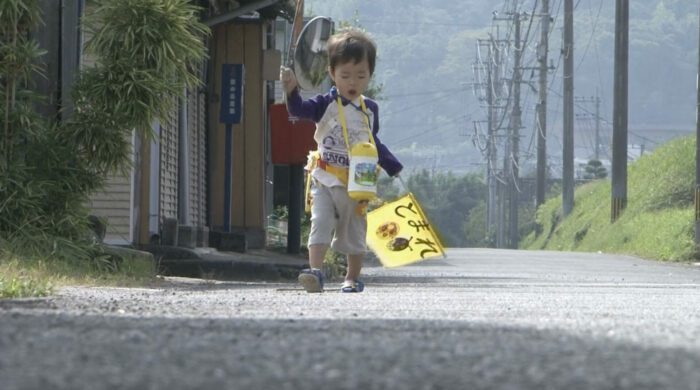
I suppose I should finally get to my point—but my hope is that you’ve figured it out already. Do I really still need to spell out what a dark pall all of this casts on American culture? Okay, okay, let’s recap:
Walkable cities. Robust, well maintained public transit infrastructure. Rich local cultures with ancient roots, thriving regional traditions, and ways of life intimately tied to their natural landscapes—from stunning “castle towns” to rural multi-generational family farms to a city in the shadow of Mount Fuji where all local prosperity depends upon the mountain’s bounty. And most jarringly of all, to a jaded Westerner: interwoven communities where parents feel safe letting small children roam free without concern for dangers like kidnapping or mass shootings—and can even reasonably expect neighbors, strangers, and establishments to aid and support their children.
Of course, I acknowledge that this is a very Western-/US-centric perspective on an East Asian program—and it’s also quite plausible that Hajimete no Otsukai and its descendant Old Enough! give a slightly distorted, idealized portrait of Japanese life, perhaps even to the original Japanese audience. But engaging with the show as it is presented to us, from an American point of view because it’s unfortunately the one I have, it’s all but impossible not to draw these contrasts.
I should add a caveat here about “Japanophilia.” There’s a long, tired history of white Westerners, especially Americans, fetishizing Japanese culture, media, and bodies. (We all knew That One Guy, and if you didn’t, stop being him.) In such idealizations of Japan, there can often be a certain erasure or whitewashing of the socially conservative streak in parts of Japanese culture, and of the nation’s history of atrocities. It’s then no coincidence that Japanophilia is generally strongest in a fundamentally right-wing slaver/colonizer state like the US, and that one of the most vile cesspools of fascist delusion in online “culture” originated as an anime message board for English-speaking Westerners.
I bring all this up not to disparage Japanese culture, but to make it clear that the intention here is not to fetishize another culture that, on many levels, shares a number of deep problems with my own. (And hey, I seem to recall the US itself doing some pretty fucked up shit to Japan and to Japanese people.)
Specifically relevant to assessing Old Enough! as an American is the troubling possibility that the kind of trust and community spirit it depicts may be easier to come by in relatively ethnically homogenous societies—a premise that is a beloved talking point of internet Nazis, but tragically may have a modicum of truth to it if only because of the pernicious influence of latent ethno-nationalism as in that very sentiment. This is all to say that at minimum, conscious Americans must recognize that safe and free access to public spaces is not equitably distributed; I wonder whether some of the nice, white, middle-class viewers who find the contents of Old Enough! shocking would themselves offer to help out a child traveling alone—and what factors about that child might inform their decision.
Now that I’ve gotten all of that disclaiming out of the way, let’s be real: if you’re an American viewer watching Old Enough!, and if you are being honest with yourself, you know that what it suggests to you is a better world that feels tragically out of reach. Especially for Millennials like myself, who came of age under a blatantly stolen national election and a future-stealing economic collapse, only to be betrayed by our perceived populist savior, the alternate reality on offer here is hypnotically idyllic. Saddled with debilitating, predatory debt and a pervasive loneliness epidemic; with the American “dream” of homeownership or even having kids of our own feeling increasingly out of reach; watching nearly 8,000 children a year get injured or killed by firearms…what in the name of Goddess could possibly be a more beautiful, comforting, escapist fantasy than My First Errand?
All of this is a way of communicating that there are a number of reasons why you should be watching, and thinking about, Old Enough! First and foremost, of course, is that it’s a great show: pure and perfect full-spectrum entertainment of the highest caliber; curated and curated and fucking curated down into smooth, refined, laser-focused binge-bait in a superconductive state; the televisual meal-replacement bar of the gods, densely packed with indulgent flavors and essential nutrients.
Another is that it offers us a wake-up call about the sorry state of most societies today, intentionally gutted to a husk as they have been by violent capitalist projects like privatization, social atomization, the dismantling of public services, and the decimation of the commons.
But within that black mirror’s dystopian reflection hides a third, genuinely utopian reason to immerse yourself in this dream, even if its depictions aren’t completely accurate: as an act of pure image-making, Old Enough! reminds our weary, beaten hearts that another world is possible.

